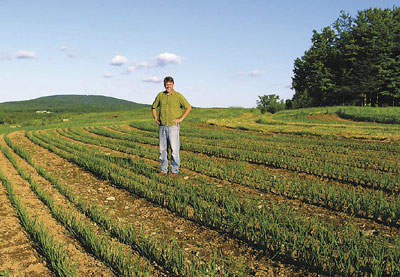 |
| Eric Gallandt, associate professor of weed ecology and management at the University of Maine, has had Maine farmers comparing the “Weed Master,” a glorified wheel hoe from Finland, with other methods of mechanical weed control. Here, Gallandt stands in a field of onions at Peacemeal Farm in Dixmont during one of MOFGA’s Farm Training Project meetings. English photo. |
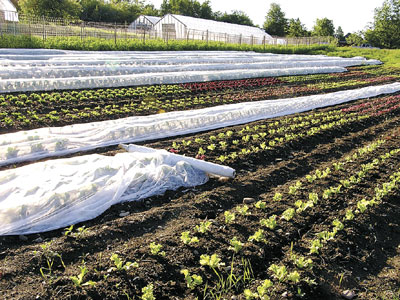 |
| These lettuce beds show how well weeds are controlled at Peacemeal. English photo. |
By Jean English
Peacemeal Farm in Dixmont, owned by Mark Guzzi and Marcia Ferry, was once a haven for weeds. When the couple took over the certified-organic farm in 2000, said University of Maine weed ecologist Eric Gallandt, it had 35,000 germinable weed seeds per square meter; that number is below 5,000 now. Methods for controlling weeds organically were covered at Peacemeal at a MOFGA Farm Training Project workshop in mid-June, attended by 75 MOFGA apprentices, journeypeople and others.
Guzzi and Ferry, who have 16 acres in cultivation, including 10 in mixed vegetables, do some cultivation by tractor but, because of the contour of their land, do more by hand – by wheel hoe, scuffle hoes and small, triangular hand hoes sold by Johnny’s Selected Seeds. A key practice is to “weed early enough so that we’re not looking for the crop through the weeds,” said Guzzi. A dozen people might be weeding every sunny day early in the season.
“When we started, there were times when we lost a crop to weeds. It’s been a long time since that happened.”
Gallandt pointed out that the fields generally contain more annual weeds, because the farm’s soils are disturbed every year; while at the edges of the fields, perennials such as quackgrass creep in.
Cover cropping can increase perennial weed problems, said Gallandt. “With a full season of red clover, if quackgrass is already there, it will explode” because the site is not being cultivated.
“How can you impose a diversity of disturbances to minimize different weeds so that you don’t end up with specialist weeds?” Gallandt asked. “Time the soil disturbance so that it coincides with when the weed wants to grow,” he advised.
For the cool season quackgrass, that’s early and late in the season. “Till it; it resprouts. When it’s about 4 inches tall, till it again. The rhizomes dry out within a day if it’s hot and dry and the rhizomes are completely exposed. If they’re buried just an inch deep, they won’t dry.”
April is a good time to start controlling quackgrass. Galinsoga, on the other hand, is a warm season annual weed. “Till the soil now [in mid-June] to encourage galinsoga to grow,” said Gallandt. “It wants to grow now. April is too cool for galinsoga to germinate, so you’d waste time preparing a sterile seedbed then to encourage galinsoga to germinate.”
Weed Control Tools
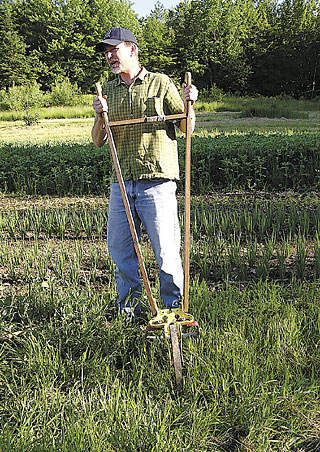 |
| Gallandt stands with The Pig, a wheel hoe with a steel wheel, one of three main weed control tools at Peacemeal. The scuffle hoe and hand hoe are the other two. Because he farms on the contour of a hill, Peacemeal owner Mark Guzzi finds that these tools work best for him. English photo. |
One of three main weed control tools at Peacemeal is “The Pig,” a copy of the Planet Junior No. 17 that was made by Red Pig tools, now in Oregon. “Although not presently available,” writes Gallandt on his blog (https://gallandt.wordpress.com/), “Rita Denman of Red Pig Tools indicated that they have plans to reintroduce ‘Red Pig No. 1,’ which they hope will be available in the spring of 2010.”
Guzzi said The Pig is a standard wheel hoe but it has steel wheels – a big advantage over rubber wheels, which bounce off rocks. And “the steel wheel lasts forever,” he said. The Peacemeal team also likes the heavy cast frame of The Pig, added Gallandt. Guzzi said that attachments available for The Pig include bed sweeps and a V-plow, and a Glaser 12-inch stirrup hoe fits on it. “With 15-inch rows,” said Guzzi, “it gives you 1 to 3 inches between [the stirrup hoe blade] and the crop.” Then Guzzi and his crew can use a 7 1/2-inch stirrup hoe to get closer to the row, and finally the hand hoe for in-row weeding.
The Weed Master
Workshop participants got to see the Weed Master in action. This is an $8,000 “glorified wheel hoe” that Gallandt imported from Finland to test on Maine farms, using a grant from the Maine Agricultural Center. It gives very quick control of a large percentage of weeds. The machine was tested in an onion weeding race at the Fisher Farm in Winterport (see https://gallandt.wordpress.com/). These were level beds with straight rows.
On his blog, Gallandt wrote that one bed had an average of 45 weed seedlings per [1/16-square-meter] quadrat before it was weeded with a collinear hoe, and 12 afterward, a reduction of 73 percent in the 12 minutes it took to weed this bed. Five other beds were cultivated with the Weed Master and finger weeders, taking an average of 2 minutes 30 seconds per bed. Weed control efficacy for these treatments ranged from 44 to 62 percent (average, 55 percent).
“Killing the weeds in the row – that’s where the money is,” said Gallandt. “If you can get 1 cm closer to the crop row, that’s potentially one-half hour saved.”
The Weed Master was also compared with The Pig and with a scuffle hoe at Peacemeal. Gallandt wrote: “Considering only the working time, the Weed Master was the clear winner. With the finger weeders it took 7 min. 10 sec. to weed the three rows of onions in the 216 ft. bed; with sweeps, 10 min. 20 sec. This compares to 13 min. 58 sec. for The Pig and 29 min. 6 sec. for the scuffle hoe.
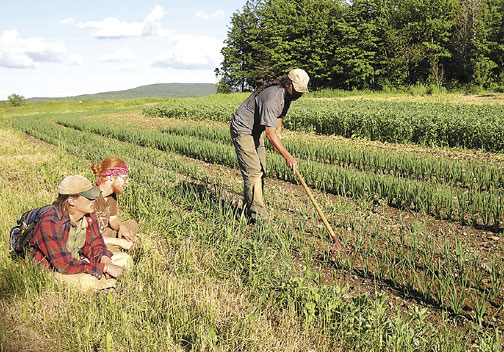 |
| In addition to going through beds with The Pig, Mark Guzzi and his crew at Peacemeal weed with scuffle hoes and hand hoes. English photos. |
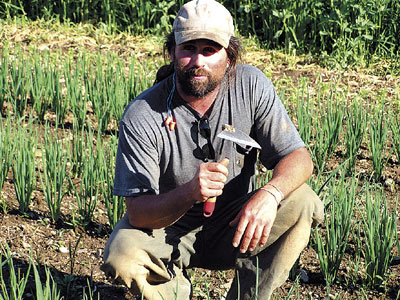 |
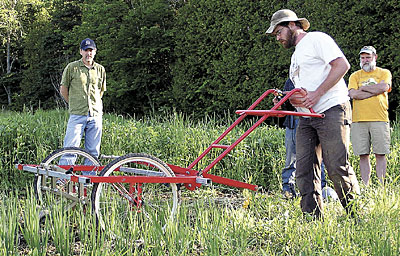 |
| Clayton Carter tries the Weed Master at Peacemeal Farm while Eric Gallandt and Russell Libby look on. English photo. |
“However, the Weed Master can only weed one row at a time and we could not set up the parallel linkages in one location on the tool bar that would be suitable for both the center and the outside rows. Mark [Guzzi] started with the linkages adjusted for the center row, but at the end of this pass he had to move them to the side to cultivate the outside rows.” Adding this “fiddling time,” the Weed Master with finger weeders took 13 minutes 16 seconds, compared with 13 minutes 58 seconds for The Pig. The total time for the Weed Master with sweeps was 14 minutes 30 seconds.
Gallandt is most excited about the parallel linkage of the Weed Master, which keeps attachments at the exact depth the farmer sets them, even when the rest of the machine goes over rocks or uneven ground. Attachments made for the Weed Master include disk hillers, finger weeders (which can be adjusted to go very close to the crop row, and which control weeds that are 1 inch tall or shorter), sweeps and a flame weeder.
Grower Clayton Carter, who has been trialing the Weed Master at his Fail Better Farm in Montville, likes the fact that he can adjust the tool by hand, without wrenches, for different spacings. The sweeps, the most aggressive attachment to the Weed Master, went through his 2-foot-tall garlic and took out quackgrass and large horsetail weeds. He was able to cultivate 2,600 bed-feet in 1 1/2 hours with the Weed Master. As an aside, Carter mentioned a friend’s theory that a grower should be able to cultivate everything on the farm in a day.
Some growers found the Weed Master “kind of hard” to push up a grade. Guzzi found it difficult to use on his onion rows that are planted on the contour of a slope – one reason he’s always fallen back on hand tools.
Gallandt said that the Weed Master kills about the same number of weeds as hand tools but does it faster. If beds are a little crowned, however, or crops are a little small, weeding by hand with a scuffle hoe can enable a person to slow down and take more care. He discusses more details in his blog.
Whatever the tool, Guzzi said that he had finally learned how to grow onions: “Do 10 weeding activities in the field on average.”
Other Weed Control Activities
In addition to mechanical weeding, Guzzi rotates – often with his favorite crop, faba beans (Vicia faba, also called fava beans, bell beans or broad beans), mixed with oats. He prefers the beans to peas, because they enable him to rotate more easily with his edible pea crop. He can plant faba beans and oats early, then grow a late summer or early fall vegetable crop after them. The hollow stems of the faba beans are easy to turn under and enable the crop to decompose quickly; and the roots “are just covered in nodules.”
Guzzi gets faba seed from Peaceful Valley Farm Supply (www.groworganic.com) in California and currently mixes 100 pounds of faba beans with 50 pounds of oats and broadcasts about 200 pounds per acre of the mix. The bean seed costs $1 per pound. “It would cost about $350 per acre to get that much N from other organic-approved N sources,” said Guzzi.
Eric Sideman, MOFGA’s organic crop specialist, advised plowing the bean/oat mixture down before weeds such as quackgrass and shepherd’s purse, which can survive in the shade of the cover crop, go to seed.
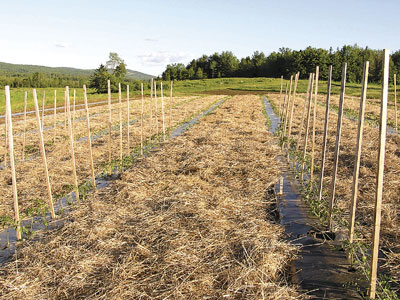 |
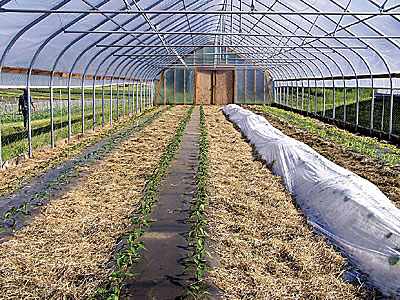 |
| Black plastic and straw mulch also control weeds at Peacemeal, in field and greenhouse crops. English photos. |
In another weed control effort, Guzzi is growing tomatoes and peppers on black plastic mulch with straw mulch between rows. The mulch should also cut down on early blight and will add organic matter to the soil.
During a discussion about bedstraw, Sideman said to mow it or graze it before it goes to seed. One farmer said he was able to control it by grazing cattle.
